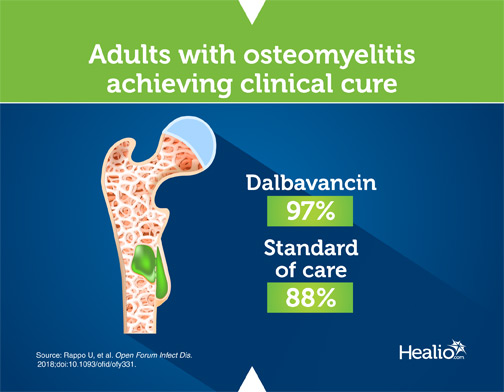2-dose regimen of dalbavancin effectively treats osteomyelitis

A two-dose regimen of dalbavancin — a long-acting lipoglycopeptide antibiotic approved for the treatment of acute bacterial skin and skin structure infection — is effective and well-tolerated for the treatment of osteomyelitis in adults, according to findings from a randomized clinical trial.
“Osteomyelitis in adults is a major clinical challenge and typically involves up to 6 weeks of parenteral and oral antibiotics,” Urania Rappo, MD, PharmD, director of clinical development for anti-infectives at Allergan, and colleagues wrote. “Better treatment options are needed which would not require an indwelling catheter, unnecessary inpatient stays, or long-term administration of daily IV or oral antibiotics in order to improve compliance and avoid associated toxicities.”
Rappo and colleagues conducted a phase 2, single-center, randomized, open-label, comparator-controlled, parallel group study from March 2016 to December 2017 at a teaching hospital in Ukraine that also participated in three pivotal trials testing dalbavancin. Marketed as Dalvance (Allergan), dalbavancin was approved in the United States in 2014 for the treatment of acute bacterial skin and skin structure infections caused by susceptible strains of certain gram-positive bacteria.
The purpose of the trial “was to describe the efficacy and safety of dalbavancin for the treatment of osteomyelitis known or suspected to be caused by gram-positive pathogens in adults,” they wrote.
They enrolled adults aged 18 years or older with a first episode of osteomyelitis. The dalbavancin group comprised 70 patients, of which 67 patients received 1,500 mg of IV dalbavancin on days 1 and 8. The control group included 10 patients, of which 8 received standard of care antibiotics for osteomyelitis for 4 to 6 weeks, depending on investigator judgment. Rappo and colleagues assessed clinical response at 21 days, 42 days, 6 months and 1 year. Clinical response at day 42 — defined as recovery without a need for additional antibiotics — was the primary endpoint. All enrolled patients had baseline debridement, and 60% were infected with Staphylococcus aureus, making it the most common pathogen.
According to study findings, 97% (n = 65) of patients receiving dalbavancin achieved clinical cure at day 42, compared with 88% (n = 7) receiving standard of care. Additionally, Rappo and colleagues observed a similar clinical response at day 21, 6 months and 1 year in the dalbavancin group. Specifically, 94% of patients receiving dalbavancin saw clinical improvement at 21 days and 96% saw clinical cure at 1 year. Although no patient discontinued treatment because of adverse events, 10 patients in the dalbavancin group experienced treatment-emergent adverse events.
“The high microbiologic potency of dalbavancin, combined with the prolonged tissue exposure at the site of osteomyelitis and high clinical cure rates observed in this study, make dalbavancin a convenient and effective option for an infection which has historically been burdensome for patients, providers and the health care system,” Rappo told Infectious Disease News. – by Marley Ghizzone
Disclosures: Rappo is an employee of Allergan plc. and reports holding stock in the company. Please see the study for all other authors’ relevant financial disclosures.

